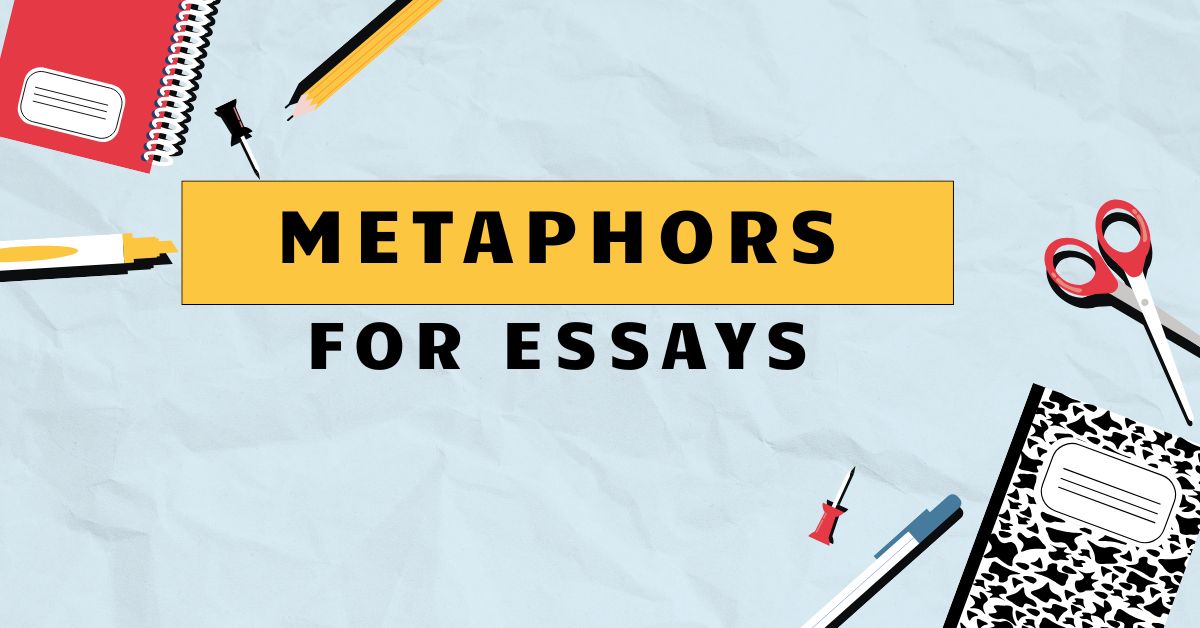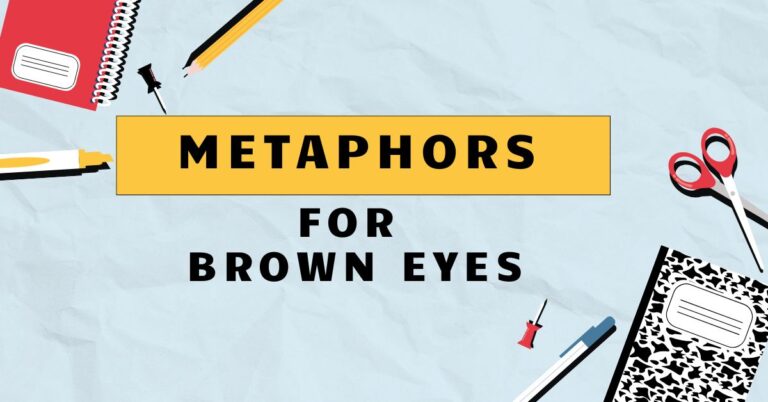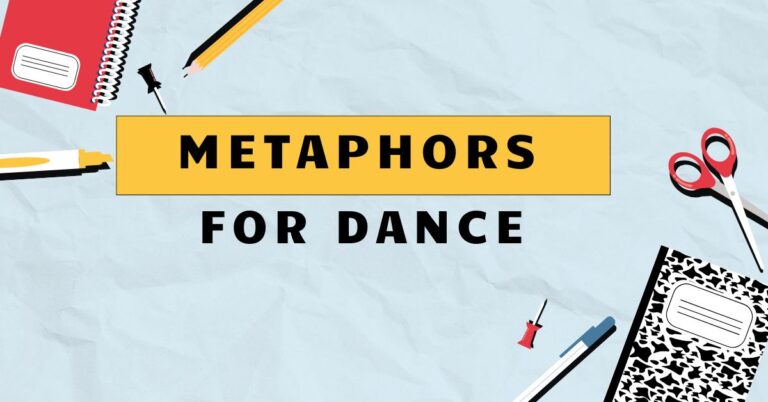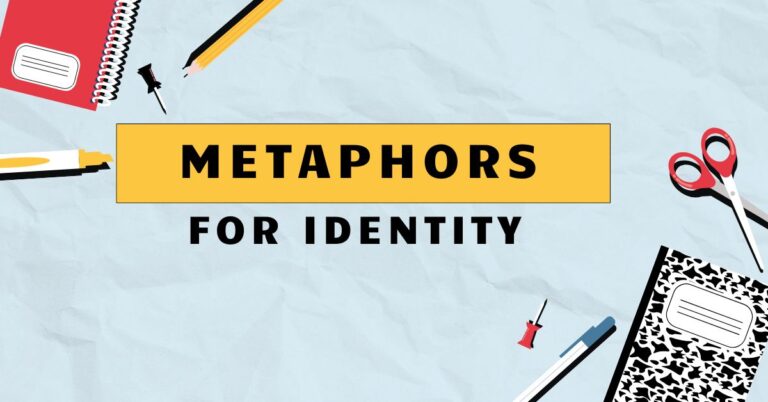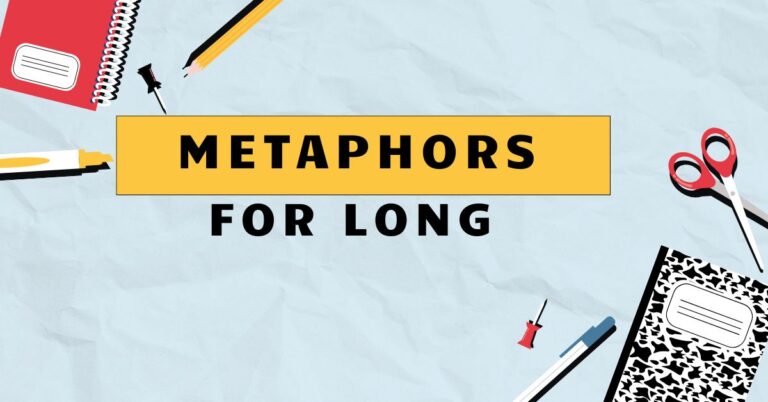39 Metaphors: Enhancing Your Essays with Figurative Language
Metaphors are powerful tools that can elevate your essays from simple statements to vivid and engaging pieces of writing. Understanding and effectively using metaphors is crucial for adding depth, creativity, and persuasiveness to your arguments.
This article provides a comprehensive guide to metaphors, covering their definition, structure, types, usage rules, common mistakes, and practice exercises. Whether you’re a student learning to write better essays or a professional looking to refine your writing skills, this guide will equip you with the knowledge and techniques to master the art of using metaphors.
Table of Contents
- Introduction
- Definition of Metaphor
- Structural Breakdown of Metaphors
- Types of Metaphors
- Examples of Metaphors
- Usage Rules for Metaphors
- Common Mistakes with Metaphors
- Practice Exercises
- Advanced Topics in Metaphor Usage
- Frequently Asked Questions
- Conclusion
Definition of Metaphor
A metaphor is a figure of speech that directly compares two unrelated things, ideas, or concepts without using “like” or “as.” Unlike similes, which use these words to make comparisons explicit, metaphors imply a resemblance by stating that one thing is another. This creates a more vivid and imaginative connection in the reader’s mind.
The primary function of a metaphor is to transfer qualities or characteristics from one thing (the source) to another (the target). This transfer illuminates the target in a new and often surprising way.
Metaphors add depth and complexity to writing, making it more engaging and persuasive. They are used extensively in literature, poetry, speeches, and everyday conversation to convey abstract ideas, evoke emotions, and create memorable images.
Metaphors are essential in essays because they allow writers to explain complex topics in a simpler, more relatable way. They can also be used to strengthen arguments by highlighting similarities between seemingly disparate concepts, thereby persuading the reader to accept a particular viewpoint.
The effective use of metaphors demonstrates a strong command of language and enhances the overall quality of the essay.
Structural Breakdown of Metaphors
Understanding the structure of a metaphor is crucial for using them effectively. A metaphor consists of two main components: thetenorand thevehicle.
The tenor is the subject to which metaphorical characteristics are attributed, and the vehicle is the object whose characteristics are borrowed. Let’s analyze this structure in further detail.
Thetenoris the concept, object, or idea that you are trying to describe or explain. It is the underlying subject of the metaphor.
For example, in the metaphor “Life is a journey,” life is the tenor. It is what you are trying to understand better through the metaphor.
Thevehicleis the image, object, or idea that is used to represent the tenor. It provides the qualities or characteristics that are being transferred to the tenor.
In the “Life is a journey” metaphor, “journey” is the vehicle. The characteristics of a journey (e.g., having a path, facing obstacles, making progress) are being applied to life.
Thegroundis the shared characteristics or similarities between the tenor and the vehicle. It is the basis for the comparison and the reason why the metaphor works.
In our example, the ground might be the idea that both life and a journey involve a series of experiences, challenges, and destinations.
To illustrate this further, consider the metaphor “The internet is an information superhighway.” Here, the internet is the tenor, and “information superhighway” is the vehicle. The ground is the idea that both the internet and a superhighway facilitate the rapid and efficient movement of something (information and vehicles, respectively).
Types of Metaphors
Metaphors come in various forms, each with its unique characteristics and applications. Understanding these types can help you choose the most appropriate metaphor for your writing.
Standard Metaphors
Standard metaphors are those that are commonly used and easily understood. They often involve familiar concepts and create clear connections between the tenor and the vehicle.
These metaphors are effective for conveying simple ideas or adding a touch of creativity to your writing.
For instance, saying “He is a lion in battle” is a standard metaphor. It quickly conveys the idea that someone is brave and fierce.
Similarly, stating “Time is money” implies that time is a valuable resource that should be used wisely.
Extended Metaphors
Extended metaphors are developed over several sentences or even an entire paragraph. They involve a more detailed and complex comparison between the tenor and the vehicle.
This type of metaphor allows you to explore the similarities between the two in greater depth, creating a richer and more nuanced understanding.
Consider this example: “Life is a stage. We are all actors, playing our parts.
Some enter, some exit, and the play goes on.” This extended metaphor develops the idea of life as a stage, exploring the various roles people play and the transient nature of existence.
Mixed Metaphors
Mixed metaphors occur when two or more inconsistent metaphors are combined in a single expression. This can create confusion and undermine the clarity of your writing.
It is important to avoid mixed metaphors to maintain a coherent and logical flow of ideas.
An example of a mixed metaphor is “Let’s nip it in the bud before it snowballs out of control.” Here, “nip it in the bud” suggests preventing something from growing, while “snowballs out of control” implies something gaining momentum and becoming overwhelming. These two images are inconsistent and create a confusing picture.
Dead Metaphors
Dead metaphors are those that have become so overused that they have lost their figurative meaning and are now considered clichés. These metaphors are often used without awareness of their original metaphorical nature.
While they may still be understood, they lack the impact and originality of fresh metaphors.
Examples of dead metaphors include “the heart of the matter,” “leg of a table,” and “falling in love.” These phrases were once creative and evocative, but they have become so common that they are now considered literal expressions.
Examples of Metaphors
To further illustrate the concept of metaphors, let’s examine a variety of examples categorized by common themes. This will help you understand how metaphors can be used in different contexts to convey various meanings.
The following tables provide numerous examples of metaphors, categorized for clarity and ease of understanding. Each example is designed to illustrate how metaphors can add depth and richness to your writing, making it more engaging and persuasive.
| Metaphor | Explanation |
|---|---|
| Her heart was a frozen tundra. | Describes a lack of emotion or warmth. |
| His anger was a raging fire. | Conveys intense and destructive anger. |
| Joy is sunshine on a cloudy day. | Joy is warmth and happiness that illuminates even the saddest times. |
| Sadness is a deep ocean. | Sadness can be a vast, overwhelming, and profound experience. |
| Fear is a silent killer. | Fear can be insidious, paralyzing, and destructive. |
| Hope is a fragile seed. | Hope is delicate, requiring care and nurturing to grow. |
| Love is a battlefield. | Love involves struggles, challenges, and conflicts. |
| Grief is a heavy cloak. | Grief is a burden that weighs one down. |
| Anxiety is a relentless storm. | Anxiety is persistent, turbulent, and overwhelming. |
| Despair is a bottomless pit. | Despair is a state of hopelessness with no apparent escape. |
| Contentment is a gentle breeze. | Contentment is calming, subtle, and pleasant. |
| Loneliness is a cold wasteland. | Loneliness is isolating, desolate, and emotionally barren. |
| Excitement is an electric current. | Excitement is energizing, stimulating, and thrilling. |
| Jealousy is a green-eyed monster. | Jealousy is destructive, consuming, and irrational. |
| Resentment is a festering wound. | Resentment is painful, damaging, and worsens over time. |
| Peace is a tranquil lake. | Peace is calm, serene, and undisturbed. |
| Frustration is a brick wall. | Frustration is an obstacle that prevents progress. |
| Guilt is a haunting shadow. | Guilt is persistent, inescapable, and weighs on one’s conscience. |
| Apathy is a thick fog. | Apathy is obscuring, disorienting, and prevents clear perception. |
| Eagerness is a coiled spring. | Eagerness is ready, energetic, and full of anticipation. |
| His enthusiasm was a boundless ocean. | Describes limitless and overflowing energy. |
| Her patience was a steel trap. | Conveys unshakeable and unwavering endurance. |
| Their friendship was a sturdy bridge. | Describes a reliable and supportive connection. |
This table showcases how metaphors can effectively convey the intensity and nature of various emotions, adding depth and nuance to your writing.
| Metaphor | Explanation |
|---|---|
| Time is a thief. | Time steals away moments and opportunities. |
| Time is a river. | Time flows continuously and cannot be stopped. |
| Time is money. | Time is a valuable resource that should be used wisely. |
| Time is a healer. | Time can ease pain and help one recover from difficult experiences. |
| Time is an ocean. | Time is vast, boundless, and immeasurable. |
| Time is a ticking bomb. | Time is running out, and a critical moment is approaching. |
| Time is a dance. | Time is rhythmic, flowing, and involves a series of movements. |
| Time is a sculptor. | Time shapes and molds everything over its passage. |
| Time is a mirror. | Time reflects past events and experiences. |
| Time is a teacher. | Time provides lessons and insights through experience. |
| Time is a fleeting moment. | Time is brief, transient, and quickly passes. |
| Time is a relentless pursuer. | Time is constantly moving forward, never stopping or slowing down. |
| Time is a treasure. | Time is precious and should be cherished. |
| Time is a labyrinth. | Time can be complex, confusing, and challenging to navigate. |
| Time is a gatekeeper. | Time determines when opportunities arise and pass. |
| Time is a silent observer. | Time witnesses all events without intervening. |
| Time is a cosmic clock. | Time is an organized and precise measure of events in the universe. |
| Time is a flowing stream. | Time continuously moves forward, like a stream flowing towards the sea. |
| Time is a burning candle. | Time gradually diminishes, much like a candle burning down. |
| Time is a patient gardener. | Time allows for growth and development with consistent care. |
| Years are stepping stones to success. | Describes how time helps us achieve our goals. |
| Life is a tapestry woven by time. | Conveys the intricate and complex nature of life. |
| The future is a blank canvas. | Describes the unlimited possibilities that lie ahead. |
This table provides metaphors that illustrate the multifaceted nature of time, highlighting its value, flow, and impact on our lives.
| Metaphor | Explanation |
|---|---|
| Knowledge is a treasure. | Knowledge is valuable and worth acquiring. |
| Ideas are seeds. | Ideas have the potential to grow and develop. |
| The mind is a garden. | The mind needs to be cultivated and nurtured. |
| Education is a ladder. | Education helps one climb to higher levels of achievement. |
| Wisdom is a guiding light. | Wisdom provides direction and clarity. |
| Challenges are stepping stones. | Challenges help one progress and grow. |
| Success is a journey. | Success involves a series of steps and experiences. |
| Failure is a lesson. | Failure provides opportunities for learning and improvement. |
| Opportunity is a door. | Opportunity provides access to new possibilities. |
| Change is a constant. | Change is an inevitable and ongoing process. |
| Inspiration is a spark. | Inspiration ignites creativity and motivation. |
| Curiosity is a compass. | Curiosity guides one towards new discoveries. |
| Imagination is a playground. | Imagination allows for freedom, creativity, and exploration. |
| Innovation is a bridge. | Innovation connects the present to the future. |
| Justice is a balancing scale. | Justice aims to achieve fairness and equilibrium. |
| Truth is a beacon. | Truth provides clarity and guidance. |
| Deception is a web. | Deception is intricate, ensnaring, and difficult to escape. |
| Doubt is a shadow. | Doubt obscures clarity and creates uncertainty. |
| Belief is an anchor. | Belief provides stability and security. |
| Hope is a lifeline. | Hope provides support and sustenance during difficult times. |
| A problem is a puzzle waiting to be solved. | Describes challenges as opportunities for intellectual engagement. |
| Information is the currency of the modern age. | Conveys the value and importance of knowledge in today’s world. |
| Art is a window to the soul. | Describes how art allows us to understand deeper emotions. |
This table provides metaphors that illustrate abstract ideas and concepts, making them more relatable and understandable.
| Metaphor | Explanation |
|---|---|
| He is a rock. | He is stable, reliable, and strong. |
| She is a ray of sunshine. | She is cheerful, optimistic, and brings joy to others. |
| He is a night owl. | He is active and alert at night. |
| She is an open book. | She is transparent and easy to understand. |
| He is a lone wolf. | He prefers to be alone and independent. |
| She is a social butterfly. | She is outgoing and enjoys socializing. |
| He is a workhorse. | He is hardworking and diligent. |
| She is a fountain of knowledge. | She is very knowledgeable and informative. |
| He is a diamond in the rough. | He has potential but needs refinement. |
| She is a force of nature. | She is powerful and unstoppable. |
| He is a rolling stone. | He is restless and constantly moving. |
| She is a pillar of strength. | She provides support and stability to others. |
| He is a shining star. | He is talented and successful. |
| She is a breath of fresh air. | She is refreshing and revitalizing. |
| He is a gentle giant. | He is kind and compassionate despite his size. |
| She is a walking encyclopedia. | She has a vast knowledge of various subjects. |
| He is a master of his craft. | He is highly skilled and proficient. |
| She is a true artist. | She is creative, sensitive, and expressive. |
| He is a seasoned veteran. | He is experienced and knowledgeable. |
| She is a bright spark. | She is intelligent and innovative. |
| He’s a bulldozer in negotiations. | Describes someone as aggressively pushing his own agenda. |
| She’s a chameleon in social situations. | Conveys an ability to adapt seamlessly to different environments. |
| He’s a computer when it comes to numbers. | Describes someone as being exceptionally skilled at math. |
This table provides metaphors that illustrate various personality traits and characteristics of people, making your descriptions more vivid and memorable.
Usage Rules for Metaphors
Using metaphors effectively requires adherence to certain rules to ensure clarity and impact. Here are some key guidelines to follow.
Clarity and Relevance:Ensure that the metaphor is clear and relevant to the subject matter. The connection between the tenor and the vehicle should be easily understood by the reader.
Avoid using obscure or far-fetched metaphors that may confuse or distract the audience.
Originality:Strive to use original metaphors that are fresh and imaginative. Avoid clichés and overused metaphors that have lost their impact.
A well-crafted, original metaphor can add a unique perspective and make your writing more memorable.
Consistency:Maintain consistency within your metaphors. Avoid mixing metaphors or shifting between different images in a way that creates confusion.
If you start with one metaphor, stick with it throughout the passage or paragraph.
Appropriateness:Choose metaphors that are appropriate for your audience and the tone of your writing. Consider the context and the message you are trying to convey.
A metaphor that is too informal or humorous may not be suitable for a serious or academic essay.
Avoid Overuse:Use metaphors sparingly and strategically. Overusing metaphors can make your writing seem forced and unnatural.
Use them only when they add significant value and enhance the meaning of your text.
Consider Cultural Context:Be mindful of cultural differences when using metaphors. Some metaphors may have different meanings or connotations in different cultures.
Ensure that your metaphors are culturally appropriate and will be understood by your intended audience.
Ground the Metaphor: Be sure the reader can understand the basis for your comparison. The shared characteristics between the tenor and vehicle should be evident, even if not explicitly stated.
Common Mistakes with Metaphors
Even experienced writers can make mistakes when using metaphors. Being aware of these common errors can help you avoid them and improve the quality of your writing.
Mixed Metaphors: As mentioned earlier, mixing metaphors is a common mistake that can create confusion and undermine the clarity of your writing. Always ensure that your metaphors are consistent and coherent.
Overused Metaphors: Using clichés and overused metaphors can make your writing seem unoriginal and uninspired. Strive to create fresh and imaginative metaphors that will capture the reader’s attention.
Inappropriate Metaphors: Choosing metaphors that are not appropriate for your audience or the tone of your writing can be detrimental. Always consider the context and the message you are trying to convey.
Unclear Metaphors: Using metaphors that are too obscure or difficult to understand can confuse the reader and detract from your message. Ensure that your metaphors are clear and accessible.
Forced Metaphors: Trying too hard to incorporate metaphors into your writing can make it seem forced and unnatural. Use metaphors only when they add significant value and enhance the meaning of your text.
Here are some examples of common mistakes with metaphors, along with corrections:
| Incorrect | Correct | Explanation |
|---|---|---|
| “Let’s grab the bull by the horns and nip it in the bud.” | “Let’s tackle the problem head-on.” | The original sentence mixes two inconsistent metaphors. |
| “He was a fish out of water.” | “He felt out of place.” | The original sentence is a cliché and lacks originality. |
| “The company was a sinking ship, but we need to think outside the box.” | “The company was facing challenges, but we need to think creatively.” | The original sentence combines two unrelated metaphors. |
| “Her smile was as bright as the sun.” | “Her smile radiated warmth and joy.” | The original is a simile not a metaphor. |
| “The project was a walk in the park, but we had to climb the ladder of success.” | “The project was easy at first, but we had to work hard to achieve success.” | The original sentence mixes two inconsistent metaphors. |
| “He is burning the candle at both ends, but we need to keep our eye on the ball.” | “He is overworking himself, but we need to stay focused.” | The original sentence combines two unrelated metaphors. |
| “The plan was a house of cards, but we need to seize the day.” | “The plan was fragile, but we need to act decisively.” | The original sentence mixes two inconsistent metaphors. |
| “She was a diamond in the rough, but we need to strike while the iron is hot.” | “She had potential, but we need to act quickly.” | The original sentence combines two unrelated metaphors. |
| “The situation was a double-edged sword, but we need to think outside the box.” | “The situation had both advantages and disadvantages, but we need to think creatively.” | The original sentence mixes two inconsistent metaphors. |
| “He was a wolf in sheep’s clothing, but we need to put all our eggs in one basket.” | “He was deceptive, but we need to take a calculated risk.” | The original sentence combines two unrelated metaphors. |
By avoiding these common mistakes, you can ensure that your metaphors are clear, effective, and enhance the quality of your writing.
Practice Exercises
To reinforce your understanding of metaphors, complete the following practice exercises. These exercises will help you identify metaphors, analyze their structure, and use them effectively in your own writing.
Exercise 1: Identifying Metaphors
Identify the metaphors in the following sentences:
| Question | Your Answer | Correct Answer |
|---|---|---|
| 1. The world is a stage. | The world is a stage. | |
| 2. He is as strong as an ox. | (This is a simile, not a metaphor) | |
| 3. Her words were daggers. | Her words were daggers. | |
| 4. Time is a river flowing swiftly. | Time is a river. | |
| 5. The city is a jungle. | The city is a jungle. | |
| 6. His heart was a stone. | His heart was a stone. | |
| 7. She sings like an angel. | (This is a simile, not a metaphor) | |
| 8. The internet is an information highway. | The internet is an information highway. | |
| 9. He is a shining star. | He is a shining star. | |
| 10. Life is a rollercoaster. | Life is a rollercoaster. |
Exercise 2: Analyzing Metaphor Structure
For each metaphor, identify the tenor and the vehicle:
| Metaphor | Tenor | Vehicle |
|---|---|---|
| 1. The world is a stage. | The world | A stage |
| 2. Her words were daggers. | Her words | Daggers |
| 3. Time is a river. | Time | A river |
| 4. The city is a jungle. | The city | A jungle |
| 5. His heart was a stone. | His heart | A stone |
| 6. The internet is an information highway. | The internet | An information highway |
| 7. He is a shining star. | He | A shining star |
| 8. Life is a rollercoaster. | Life | A rollercoaster |
| 9. Friendship is a shelter. | Friendship | A shelter |
| 10. Education is a key. | Education | A key |
Exercise 3: Using Metaphors in Sentences
Complete the following sentences by adding an appropriate metaphor:
| Question | Your Answer | Example Answer |
|---|---|---|
| 1. Her anger was __________. | Her anger was a volcano erupting. | |
| 2. His determination is __________. | His determination is an unyielding fortress. | |
| 3. The challenge was __________. | The challenge was a high mountain to climb. | |
| 4. Their love is __________. | Their love is a warm, comforting fire. | |
| 5. The truth is __________. | The truth is a bright, revealing light. | |
| 6. Progress is __________. | Progress is a slow but steady climb. | |
| 7. Fear is __________. | Fear is a dark, suffocating cloud. | |
| 8. Hope is __________. | Hope is a small, flickering candle. | |
| 9. The economy is __________. | The economy is a complex, fragile system. | |
| 10. Society is __________. | Society is a tangled web of relationships. |
Advanced Topics in Metaphor Usage
For advanced learners, delving deeper into the nuances of metaphor usage can significantly enhance writing skills. Understanding abstract metaphors, crafting original metaphors, and using metaphors to create complex layers of meaning are some areas to explore.
Abstract Metaphors:Abstract metaphors involve comparing abstract concepts or ideas with other abstract concepts. These can be more challenging to create and understand, but they can also be incredibly powerful in conveying complex philosophical or emotional ideas.
For example, “Justice is blind” is an abstract metaphor that conveys the idea that justice should be impartial and unbiased.
Original Metaphors:Crafting original metaphors requires creativity and a deep understanding of language. Avoid clichés and strive to create fresh and imaginative comparisons that will capture the reader’s attention.
Pay attention to the details and nuances of the tenor and vehicle to create a meaningful and impactful connection.
Metaphorical Layers:Skilled writers often use metaphors to create multiple layers of meaning in their work. This involves using a single metaphor to convey several related ideas or themes.
For example, an extended metaphor about a journey might be used to explore themes of personal growth, self-discovery, and the challenges of life.
Subverting Expectations:Advanced metaphor use can also involve subverting expectations. This means using metaphors in unexpected or unconventional ways to challenge the reader’s assumptions and create a surprising effect.
This can be a powerful tool for engaging the reader and making your writing more memorable.
Integrating Metaphors Seamlessly: A key skill is integrating metaphors seamlessly into your writing so they feel natural and not forced. This involves choosing metaphors that fit the tone and style of your writing and using them in a way that enhances the flow of your text.
Frequently Asked Questions
Here are some frequently asked questions about metaphors:
- What is the difference between a metaphor and a simile?
A metaphor directly compares two things by stating that one thing is another, while a simile uses “like” or “as” to make an explicit comparison. For example, “He is a lion” is a metaphor, while “He is as strong as a lion” is a simile.
- Why are metaphors important in essays?
Metaphors add depth, creativity, and persuasiveness to essays. They help explain complex topics in a simpler way, strengthen arguments, and engage the reader.
- How can I avoid using mixed metaphors?
To avoid mixed metaphors, ensure that your metaphors are consistent and coherent. Avoid combining inconsistent images or shifting between different metaphors in a way that creates confusion.
- What are some examples of dead metaphors?
Examples of dead metaphors include “the heart of the matter,” “leg of a table,” and “falling in love.” These phrases have become so overused that they have lost their figurative meaning.
- How can I create original metaphors?
To create original metaphors, think creatively and look for unexpected connections between the tenor and the vehicle. Avoid clichés and strive to create fresh and imaginative comparisons.
- How often should I use metaphors in my writing?
Use metaphors sparingly and strategically. Overusing metaphors can make your writing seem forced and unnatural. Use them only when they add significant value and enhance the meaning of your text.
- What should I do if I’m not sure if a phrase is a metaphor?
Analyze the phrase to see if it’s making a direct comparison between two unlike things without using “like” or “as.” If it is, it’s likely
a metaphor. Consider the context to determine if the comparison is figurative or literal.
- Can a metaphor be more than one sentence long?
Yes, a metaphor can be extended over several sentences or even an entire paragraph. This is known as an extended metaphor, which allows you to explore the similarities between the tenor and the vehicle in greater depth.
- Is it okay to use metaphors in formal writing?
Yes, metaphors can be used in formal writing, but they should be used judiciously and appropriately. Ensure that the metaphors are clear, relevant, and enhance the meaning of your text.
- How do I know if my metaphor is effective?
An effective metaphor should be clear, relevant, and add value to your writing. It should create a vivid image in the reader’s mind and help them understand or appreciate the subject matter in a new way. Get feedback from others to see if your metaphors are working as intended.
Conclusion
Metaphors are indispensable tools for enriching essays and enhancing communication. By understanding their structure, types, and usage rules, you can effectively incorporate metaphors into your writing to add depth, creativity, and persuasiveness.
Avoid common mistakes, practice regularly, and explore advanced techniques to master the art of using metaphors. With consistent effort, you can transform your essays from simple statements into vivid and engaging pieces of writing that captivate your audience.

